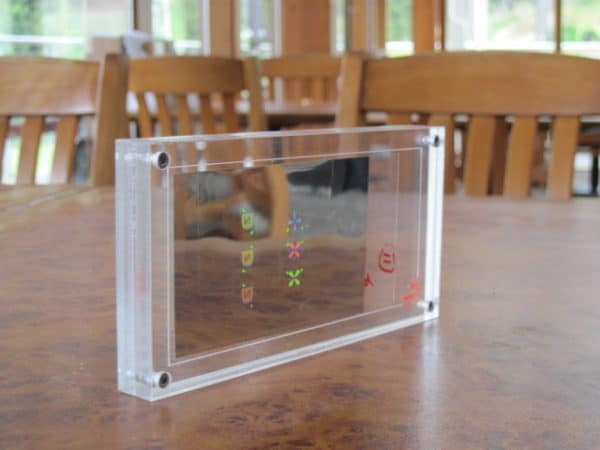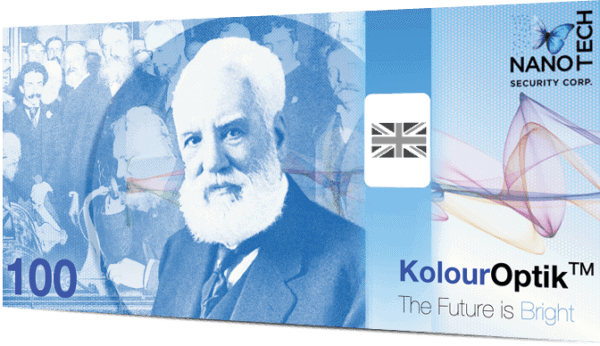

In the real world, criminals get away with crimes despite some of our best attempts to improve technology. Take counterfeiting. Those new polymer bank notes with holographic security features may be an improvement, but they are by no means perfect. And counterfeiting is big business. According to the Washington-based International Anti-Counterfeiting Coalition, it’s a $600-billion a year problem worldwide annually.
BC-based Nanotech Security (TSXV:NTS), a company that got its start barely two years ago, has turned to nature for a solution. Nanotech’s new authentication technology, N.O.T.E.S (Nano-Optic Technology for Enhanced Security), incorporates nano structures that reflect and transmit waves of light to that the company uses to encode security into devices in ways that have never been done before. This technology may ultimately prove invaluable in a range of markets that desperately need additional layers of security, such as banknotes, high end luxury goods, even pharmaceuticals, which are frequently counterfeited. Nanotech’s evolution was accelerated early on when Doug Blakeway, a security expert with international experience, was introduced to the technology through his role as Entrepreneur-in-Residence at Simon Fraser University. Cantech Letter caught up with Blakeway and the company’s Chief Technology Officer, Clint Landrock, to talk about Nanotech Security’s attempt to become one of the first companies in the world to commercialize a nanotechnology application.
Doug, can you talk a bit about how Nanotech came together?
Sure. One of my roles is entrepreneur in residence at Simon Fraser University. I look at new technologies to see whether or not they can be commercialized. Back in January of 2009 I was given a presentation, along with a group of others at the university, and something I thought had great potential caught my attention. The presentation was given by Dr. Bozena Kaminska, who is a professor at SFU and Clint Landrock, who is, of course, with us today. It was proposed that this technology should be developed into an authentication feature for bank notes. One of the federal banking agencies was inquiring whether nanotechnology could be incorporated into a banknote feature and our response was “Yes, it could.” That’s how the company was put together. From there I negotiated with the university, bought the technology from them and put the security rights into a company we had which was public. The company was previously called Wireless2 Technology Inc. We had previously sold some technology in the offender monitoring space and were left with cash in the company. We have a US subsidiary that manufactures intelligence gathering, surreptitious devices and officer safety equipment so we were looking for a security application that fit into our area of expertise. When I saw this I knew it was an absolute fit. We started to get to work on this in January of 2010.
Is security the only applicable market or have you just chosen to choose that market first for this technology?
Nanotechnology is a still such a new field, especially in terms of using it in a commercial sense. Nanotech Security Corp is very early on in its lifespan. There were three years of prior development, but no focus specific to security. It was originally explored for use in solar cells and battery efficiency. This technology has all sorts of applications in security and authentication, from banknotes to pharmaceuticals, to tax stamps, passports, concert tickets, and brand recognition.
What do you mean by brand recognition?
Say you have a valid Gucci or Louis Vuitton bag, this would absolutely validate that yours was real. This would be something like a logo that would be turning on and off and changing color with light in a specific manner that is virtually impossible to duplicate. This feature could be directly incorporated into the design of the brand.
That’s a really cool application of the technology. Did you think about wading into that market first? Luxury brands around the world must be tremendously concerned with piracy.
That is a huge market for us. We have two parts to this. We wanted to move into something that was recognized by everyone, would provide validation for our technology and we could talk about. So one of our priorities was the global banknote market, which has challenges we can discuss as we go on here. The other is the brand recognition, or authentication, is the term we thought was more descriptive. One of the marketable benefits of this technology is that it’s a pure green technology. What I mean by that is there are no pigments dyes, inks. It can be applied directly to an object, whether that be glass, plastic, metal – virtually anything. Any other branding security feature used currently has to incorporate other materials. Our technology is expensive to get into but the applications are very inexpensive to apply if you compare it to a hologram, for instance. We intend to replace anything that uses a hologram as a security feature.

I imagine the push from brands to adopt security features must be tremendous, but what is pushing the adoption of security features for bill notes?
There has been a big push from both sides, but we have actually had to shy away from talking too much about what we are doing because the banking community around the world doesn’t want anyone knowing what is being worked on before it’s released. Once it’s out there, there is no problem with talking all about it, whereas in brand recognition and authentication they want everybody to know what they are doing at all times. So we have a bit of a muzzle on ourselves when it comes to the bank note business.
So that is why the bank note business precedes the branding for you?
Correct.
Clint, let’s get into the actual technology. This was designed by replicating a process in nature?
The idea of using nanotechnology for optical effects comes from what we observe in butterflies and similar insects. They have these little nano-scale features that do a lot of interesting things that we can’t do today with current optics, but it was our inspiration for what we were going for. We actually started out using nano-optics to try and build solar cells and other kinds of structures to try and improve batteries and things like that. Once we started scaling up we realized that we had something special that could be used in anti-counterfeiting projects.
What is the purpose of this adaptation in nature?
In nature, when the Blue Morpho butterfly is flying, its brilliant blue wings appear to turn “on and off” as they reflect light. One hypothesis to explain this iridescent quality, only found on males, is it is used to attract females, or in other words make the male easier to identify. When we create structures on a nano scale, specifically referring to structures that are smaller than a single wavelength of light, we start to get new kinds of optical properties in the standard diffraction and refraction effects, and we get stronger visual effects. So you can get much bolder, brighter colors and tighter control of those colors you see. Also, when you get down to this scale, you start to introduce some aspects of quantum physics, which in our case mean some of the surface effects that actually interact with the electrons on the surface of the material, and the photons, to increase, decrease or define new kinds of colors. This technology is a series of holes, grading and pillars. When we look at a lot of these structures in nature they are super complex, which means they are actually really difficult to manufacture in an industrial sized manufacturing process, or at very least manufacture at a low cost. One of the innovations we came up with was to make sure our structures were really simple and could be scaled up fairly easily from processes that already exist today – while maintaining the features and visual properties found in nature. One example would be the embossing process, which is essentially a printing press. We load a plate that is a master of all the structure we want and imprint those structures into the material that we want to see this optical effect. This was really important because often nanotechnology gets bogged down with high complexities that lead to high costs.
You recently quoted numbers from Anti Counterfeiting Coalition out of Washington that counterfeiting is a $600-billion dollar a year problem. This is a huge market, how do you get a foothold?
Doug: It’s actually very easy to get a foothold because it is a limited supply chain that deals in the market of authentication. There are fewer than fifty companies in the world that are in authentication and you have just a handful of marketing companies that service the entire industry for security features. It is driven in two ways; one is the customer wanting something that is different and the other is the suppliers that want to keep up with what the customers are doing. So you have the suppliers pushing to the customers and the customers pushing to the suppliers. So it is a very concise and effective sales strategy and is not costly. When you get into things like pharmaceuticals, tobacco, tax stamps, passports it’s all direct. Once you have an entree into one area it leads into other areas, so your sales team doesn’t have to be that large.
Not a huge capital outlay?
That’s correct. Those marketing companies become part of your team and you’re not paying for them. They’re out there trying to move the product for you and you don’t have to compensate them, they want it, they want something different. Because there are no dyes or anything, you could, for example, put this technology on a capsule for medicine. If you picked that capsule up it would, for lack of a better word, glow and have a serial number and trademark, and indication that is was authentic. And you wouldn’t have to go through FDA. So you can see the marketing opportunities immediately, whereas you can’t do that with other security features at all today.
How long will it take to vet your security and how far along are you with it?
The real test is determining whether it will stand up to each particular application, and each type of application has its own criteria. Generally, what we are doing is running production samples and those samples are run in a specific way to qualify the product for its end use. We are presently nearing the end of that process. So far we have not met any challenges we haven’t been able to resolve.
I keep going back to this, but it does seem that now that you have developed the technology it’s not going to be very capital intensive to commercialize….
Agreed. We have a team of scientists working on this constantly improving the process, and we are continually filing patents, whether it’s on the process itself or the application of the technology. To build a shim is time consuming and expensive and requires sophisticated machinery. But at SFU we are very fortunate that we are able to use their 4D labs which have this type of machinery. In fact, when some of the companies come to visit us they normally start off with a presentation highlighting the capabilities they have and how their labs works and how much money they have spent on their lab, and it’s generally an investment of several million dollars. When we show them what we have they kind of sit there in stunned silence because they don’t have the capability that we do. So far, we haven’t run into anyone that has the complete capabilities that we have.
How far from revenue are you?
I would say next year. We currently have small amount, but I think we will start putting up significant numbers next year.
We talked about how your entry into the market will come from the bank note side, but eventually the branding market will follow. Have you had any preliminary discussion on that side you can talk about?
Yes. We are talking to four branding companies at present and the four companies are all waiting on samples from our commercial run. Branding companies have different uses in mind, whether it’s for logos or authentication of packaging. We are talking to marketing companies that represent some of the largest and most recognizable corporations in the world.
High end luxury brands must be pulling their hair out about counterfeiting.
Yes, they are, it is a huge problem. Everyone in the authentication space is looking for something new. What has been used up until now is a hologram and the industry now considers this non-secure and obsolete. Rolex, for instance, is looking for solutions that distinguish their watches from counterfeits. This leads into another aspect that makes our technology unique and has people in the industry really excited: it’s the ability to incorporate all levels of security in a single feature. We know no other technology that can do that. We are talking about authentication on multiple levels. There are generally four levels of security. One is overt, that which is visually identifiable, the next is semi-covert, where you would use some type of limited machinery to detect – and covert, where it would require sophisticated machinery. The fourth level is forensic, which goes into levels that are invisible. We have actually added one more level, and we call it encoded data. We can encode data in the background directly into the feature, which is a much higher level than even forensic. A single security feature very rarely covers more than two of these four and we can cover all five levels. And customs, by way of example, can read this with a simple optical scanner and quickly determine if the goods are genuine, whereas a knockoff hologram would be extremely difficult.
So even on that side there’s not a huge outlay of capital to access these advanced features…
No, and what you get is a lot of brands who end up saying they will give the customers officers these tools, so even the government agencies don’t have to pay for this, in many cases. Clint can tell you just how much information can be stored on these.
Clint: Yeah. If you imagine a color barcode, but instead of being able to store the same amount of info as a website link, you can store as much as is on a CD. Because the scale of this technology is so minute, we could have several megabytes of data stored in a relatively small area. So that can be used for things like facial recognition, fingerprint information. The way barcodes work now is they have information for a website, but that hyperlink takes you somewhere else, it opens up an app on your phone or something. But we could actually have all that data stored there so you wouldn’t need an additional server or network. So it’s intrinsically a lot more secure.
Last question. What do you hope to accomplish corporately in the next twelve to eighteen months?
The first thing will be to commercialize in the branding area. The other thing is to produce all our samples so we can have them in a person’s hand instead of having them watch a video. I think we will get there in the next six months.
Comment
Leave a Reply
You must be logged in to post a comment.





 Share
Share Tweet
Tweet Share
Share




hard to believe something so small can be so big…..exciting times
So cool how this started at SFU. Go Nanotech!